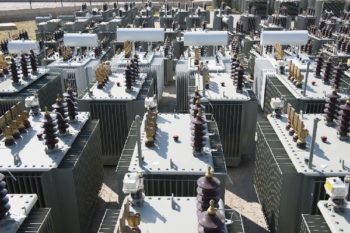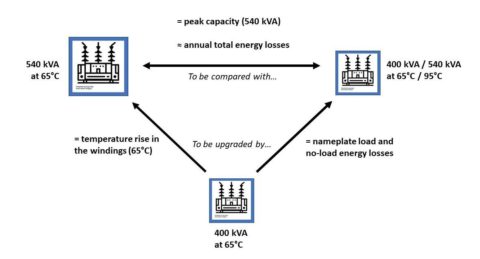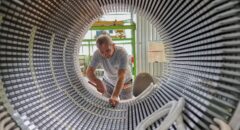The sustainable peak load concept and public distribution transformers

With recent regulatory initiatives, the EU is making a strong commitment to improving both energy and material efficiency. The sustainable peak load concept for public distribution transformers does exactly that. Is it time for its widespread application in the field?
The ambition set out in the European ‘Fit for 55%’ package (July 2021) requires that all technically and economically feasible avenues to decarbonisation be rolled out rigorously. Maximizing the energy performance of electrical distribution networks is one of these avenues. At the same time, the European Green Deal expressed the ambition of making the economy more material efficient, resulting in a new Circular Economy Action Plan (March 2020).
In the area of electrical energy, there is an inherent conflict between these twin ambitions, since a key measure for improving the energy efficiency of electrical systems is increasing the amount of conductor material. Making smart use of electrical systems can in some cases mitigate this trade-off. The sustainable peak load concept deployed in distribution transformers represents such a smart solution. It does not change the transformers themselves, but instead maximizes their output for material efficiency without compromising their energy performance.
At the origin of the concept lies the fact that many public distribution transformers, as currently rated, are underexploited. This has historical antecedents. Stringent rules on loss reduction, compactness, and absence of toxic substances have prompted various technological innovations, including the use of highly conductive winding material, magnetic steel with reduced losses, thermally upgraded paper, and natural esters as liquid insulation.
As a result, many transformers can now withstand higher temperatures in the windings, and consequently higher peak demand, without compromising unit reliability or lifetime. This potential is not usually exploited in order that losses are kept below the postulated value.
At low load levels, however, the relative importance of load losses diminishes, and the relative importance of no-load losses increases. As a result, choosing a smaller transformer for the same job has little influence on the total annual energy losses of the unit. The increase in load-losses during peak hours is balanced or exceeded by the permanent decline in no-load losses.

Public distribution networks typically have such low load levels. Until recently, their loadings have been estimated only, not measured. With the introduction of smart meters, extensive measurement campaigns have now recorded full-year kWh data, which show that loadings tend to be lower than initially thought. The average load factors tend to be around 15% of nameplate capacity.
This low load factor combined with the technical overload capacity leads directly to the concept of the sustainable peak load transformer. The ‘rated nameplate capacity’ will be the value by which the transformer will meet the energy performance regulations. The ‘sustainable peak capacity’ of the transformer will be set at a higher value. As long as the transformer operates in a network with low average loadings, as is the case in public distribution networks, allowing such a higher peak capacity will not increase the unit’s total annual energy losses.
A group of experts, under the European Copper Institute’s direction, conducted a modelling exercise to assess the impact of selecting sustainable peak load units for all transformer replacements in public distribution networks in the EU, with the following findings:
- The total annual energy losses of a sustainable peak load unit are similar to those of a conventional unit;
- The material savings potential of sustainable peak load transformers is substantial, with reductions in total weight of 11 – 15%;
- The purchase cost of a sustainable peak load transformer is comparable to that of a conventional transformer if all other parameters are kept the same.
This means that a widespread application of the sustainable peak load concept in the EU public distribution networks could make a significant contribution to the EU policy goals. It would maximize both the energy efficiency and material efficiency of public distribution transformers.
A major economic advantage of the sustainable peak load transformer is its compactness. With the transition away from fossil fuels, substantial growth in electricity consumption is expected in some sectors supplied by distribution networks. The sustainable peak load transformer provides the opportunity to upgrade transformer peak power while keeping the same unit dimensions. This is a critical aspect in urban environments with space restrictions, and allows savings on installation costs. Consequently, transformer upgrades might be made at an earlier stage, making the distribution grid more robust.
Source: Leonardo Energy
Illustrations: Copper Alliance








